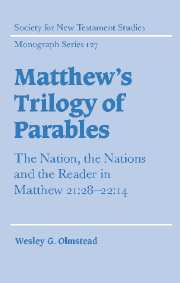Book contents
- Frontmatter
- Contents
- Acknowledgements
- Part one Prolegomena
- 1 Introduction: of authors, readers and approaches to the parables
- 2 Matthew's trilogy of parables: 21.28–22.14
- Part two The trilogy in narrative-critical perspective
- Part three The trilogy in redaction-critical perspective
- Appendix The text of the parable of The Two Sons
- Notes
- Bibliography
- Index of passages
- Index of selected topics and modern authors
1 - Introduction: of authors, readers and approaches to the parables
Published online by Cambridge University Press: 22 September 2009
- Frontmatter
- Contents
- Acknowledgements
- Part one Prolegomena
- 1 Introduction: of authors, readers and approaches to the parables
- 2 Matthew's trilogy of parables: 21.28–22.14
- Part two The trilogy in narrative-critical perspective
- Part three The trilogy in redaction-critical perspective
- Appendix The text of the parable of The Two Sons
- Notes
- Bibliography
- Index of passages
- Index of selected topics and modern authors
Summary
On reading the Gospel narratives
The landscape of Gospels scholarship has shifted dramatically in the last three decades. Redaction criticism has yielded pride of place as the primary method in Gospels studies but there has been no single obvious successor. Instead, Gospels critics offer readings from a bewildering variety of interpretive stances and, increasingly, refer to the methodological pluralism that undergirds their work.
Nevertheless, narrative criticism, in its various forms, posed some of the earliest and most persistent challenges to a redaction-critical approach. The early exponents of a more ‘literary’ approach commonly set themselves over against more traditional historical critics, mourning the poverty of a redactional approach and proclaiming the end of an era. Similar sentiments – or at least interpretations that reflect these sentiments – continue to punctuate the discourse of Gospels scholarship.
But it has also become more common for scholars on both sides of the methodological divide to call for a more cooperative, interdisciplinary approach. To date, the most significant of these have tended to operate under the assumption that literary and historically oriented methods complement one another by casting light in rather different directions. Where narrative critics focus on the unity of the final text, redaction critics turn their attention to the evangelists' reworking of their diverse sources that gave rise to the text in its ‘final’ form.
- Type
- Chapter
- Information
- Matthew's Trilogy of ParablesThe Nation, the Nations and the Reader in Matthew 21:28-22:14, pp. 3 - 21Publisher: Cambridge University PressPrint publication year: 2003



